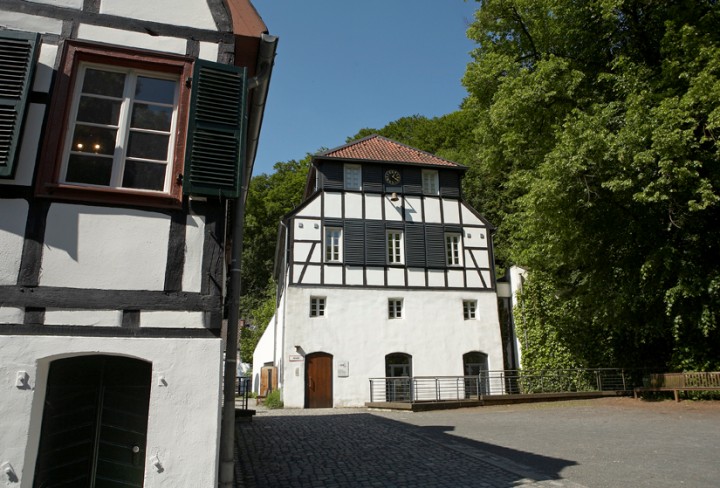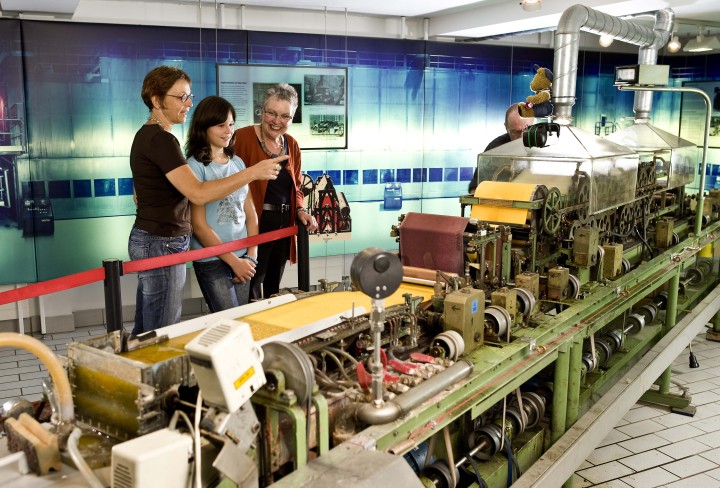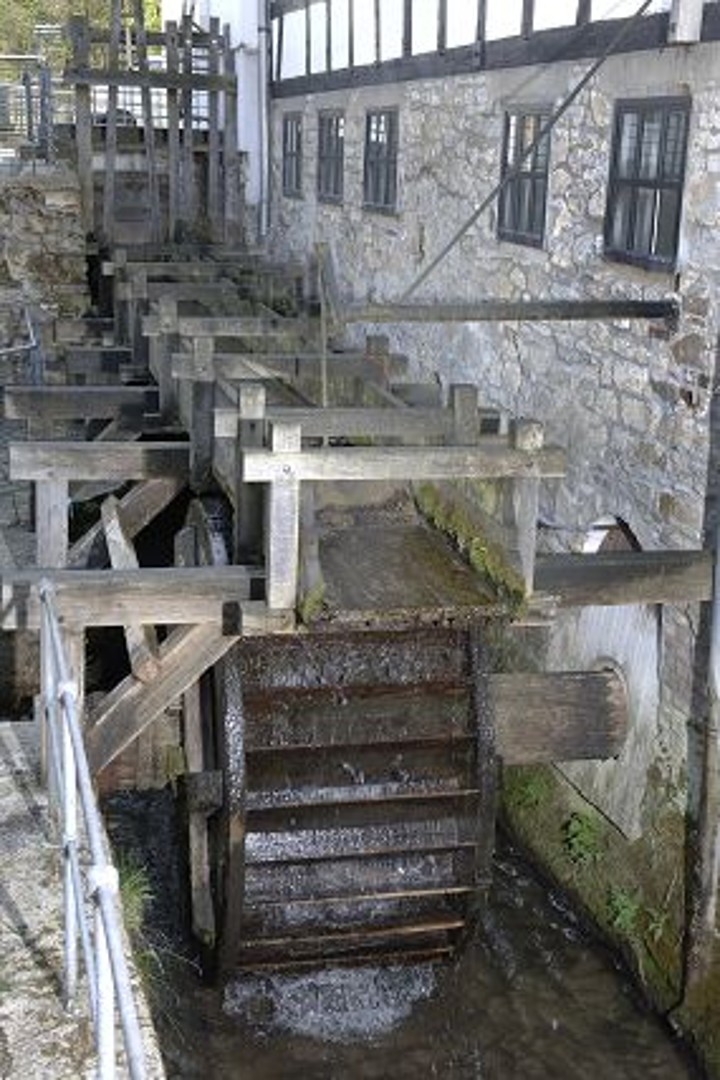
Bergisch Gladbach. Half-timbered houses in a green valley, little brooks and a clattering mill-wheel welcome the guests of the former paper mill Alte Dombach. Today in this place with its appealing atmosphere, a site of the LVR-Industriemuseum can be found. Its exciting and entertaining exhibition is dedicated to the material paper, a product which has an important part in our everyday life.
On the tour through the historical paper mill the visitors get to know how costly the production of paper and cardboard was in the time of the industrial revolution. Nowadays, 19.Million tons of paper are produced in Germany by computer-controlled machines, which are more than 100 meters long. The museum uses an interactive and vivid presentation: visitors can observe the mill wheel when driving the loud rag-pounding machine and can scoop their own sheet of laid paper from the tub. They will be confronted with the noise of a modern paper factory and can watch the creation of a paper length on a small paper machine. People thrilled by technology will be impressed by the machines from the 19th and early 20th century, especially by the 40 meter long paper machine from 1889. The detailed models of a paper mill and a paper factory show impressively the giant leap from craftsmanship to industrial production.
Not only its production, but also the meaning and use of paper are topics in the Alte Dombach. The increase of paper usage between 1800 and 2004 from half a kilo to 224 kilos per person and year in Germany is the recurring theme in the exhibition. Exhibits like a 150 year old collection of friendship letters, novels about bandits or love from the 1820s, a small theatre made of paper or historical packaging tell about the usage of paper in former times. Even the history of the toilette paper is told in the exhibition.
The outdoor area next to the buildings of the former paper mill is included into the exhibition, as well. More former historical machines can be found here. The visitors can take a look at the reconstructed mill race and stroll through the show garden, in which many different plants grow out of which paper can be produced. A glass `watercube’ and a stack of wood make clear how many of these raw materials are needed to supply one person in Germany with paper.
The Alte Dombach was not only a production site. Flats for several families of papermakers are located in the area around the mill. In a small worker’s house, the cramped accommodation, the complex and hard domestic work as well as the storage in the 19th century are revived.
The paper mill Alte Dombach was founded around 1620. Over time, it was rebuilt and extended. Today it consists of the two large production buildings, the two worker’s houses and adjoined buildings. Shortly after 1800, the Neue Dombach was founded 200 meters up the valley. In the course of the 19th century they developed into a typical factory, which produces paper in an industrial scale. The Alte Dombach was shut down in 1900, the Neue Dombach in 1930. The paper machine hall of the Neue Dombach is nowadays part of the museum. Since then the Alte Dombach shelters flats and the Neue Dombach different business enterprises. In 1987, the family and company Zanders gave the Alte Dombach to the LVR that opened a site of its museum there in 1999.
The LVR-Industriemuseum Bergisch Gladbach is a destination especially for families: either people with technical or cultural-historical interest, everybody will enjoy themself. The tour with machine demonstrations and paper scooping is especially entertaining for children and can also be purchased as an audio guide in German, English, French and Dutch. After the exhibition visit, children can romp around on the small playground on the museum’s site while their parents search the museum’s shop for beautiful things made of paper, take a fresh beverage in the café or enjoy the beautiful surrounding.
An extensive education programme with interesting activities completes the offers of the museum. Guided tours for groups can be booked for different groups of ages and subject areas. Every first Sunday in the month, guided tours for adults and especially children take place. Courses for creative work with paper and for paper scooping are offered regularly. Also celebrations are held frequently: Each year, the museum’s festival and the paper market fascinate their visitors. In addition to this programme children can celebrate their birthday in the museum.
The paper mill Alte Dombach is one of a total of seven exhibition sites of the LVR-Industriemuseum, which combined, create a unique museum. In historical factories, of which some are listed for preservation, the history of the industry in the Rhineland and its workers is told in an interesting and illustrative way. The focus is put on metal, fabrics, paper and electricity, as the local branches. Apart from the paper mill Alte Dombach the other museums are waiting to be explored: the Gesenkschmiede Hendrichs in Solingen, the Kraftwerk Ermen & Engels in Engelskirchen, the Tuchfabrik Müller in Euskirchen, the Textilfabrik Cromford in Ratingen, the Zinkfabrik Altenberg as well as the St. Antony-Hütte in Oberhausen. Furthermore, the museum’s headquarter with management, administration, depositories, library, photo archive and garages is placed in Oberhausen. Founder and bearer of the LVR-Industriemuseum is the Landschaftsverband Rheinland (LVR).
LVR-Industriemuseum
Papiermühle Alte Dombach
Alte Dombach
51465 Bergisch Gladbach
kulturinfo rheinland
Tel.: 02234 / 9921-555 (Mon-Fri 8 am – 6 pm; Sat, Sun 10 am – 3 pm)
Fax: 02234/9921300
Mail: info@kulturinfo-rheinland.de
Tuesday to Friday 10 am – 5 pm
Saturday and Sunday 11 am – 6 pm
Mondays closed
Regular entrance: 4 €, reduced 2 €
Children and adolescent up to 18 years get free admission to the museum!
The following photographs are only to be used for editorial purposes in the context of coverage about the LVR-Industriemuseum and have to be marked with the copyright “©LVR-Industriemuseum”. Their printing is free of charge, but we would like to receive a specimen copy. The usage outside of this context is prohibited.

The paper mill Alte Dombach was built in the 17th century and was in operation until around 1900. During the careful restoration of the buildings, historical techniques were used. For instance, the walls are made of beams and clay.
© LVR-Industriemuseum

In the paper mills the paper was scooped from the vat. Scooping paper on your own can be tried in the museum – a highlight for young and old.
© LVR-Industriemuseum

The LVR-Industriemuseum Bergisch Gladbach also shows how today’s paper factories are producing paper. Visitors can observe how paper is machine-made with a laboratory paper machine.
© LVR-Industriemuseum

After the production of paper was given up, buildings were rebuilt into flats. The historical tools and machines vanished almost entirely. For the museum the mill ditch was compiled again and a new mill wheel was installed.
© LVR-Industriemuseum